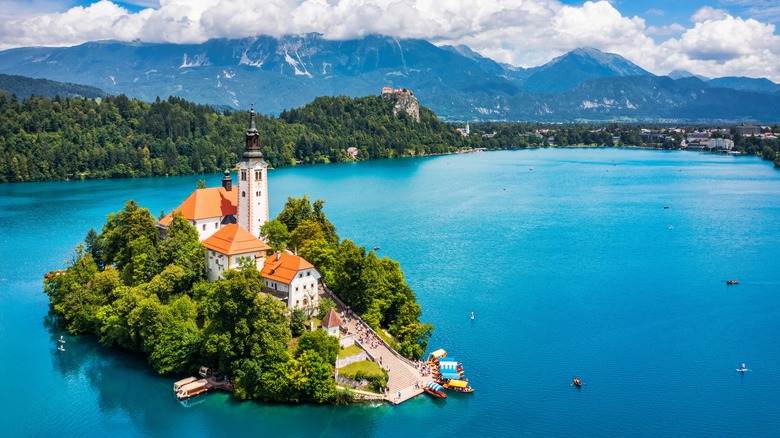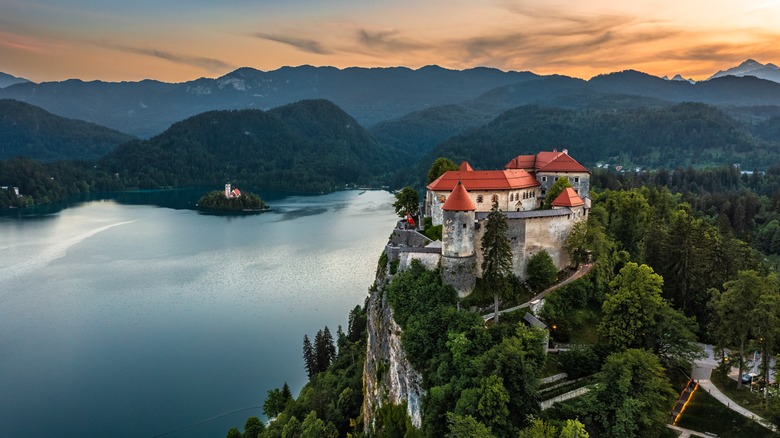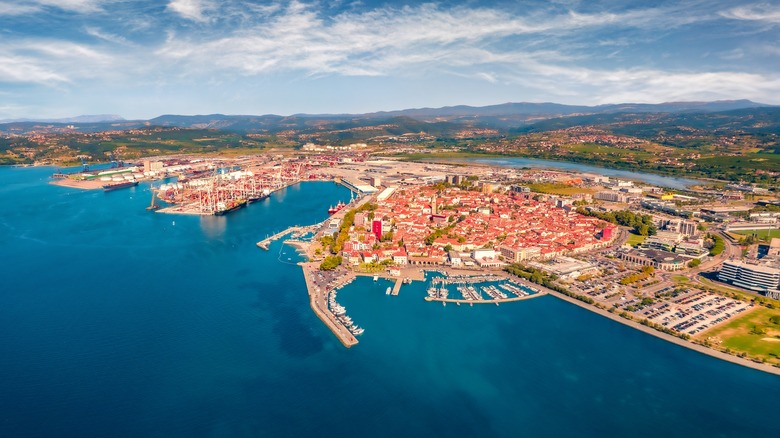This European Country Has Only One Natural Island Left And It Looks Like A Medieval Fairytale
If you catch Bled, Slovenia, on a foggy day, and you may think you've stepped into the mists of Avalon — or floated. The illusion grows as the bell tower of the island church, Assumption of the Blessed Virgin Mary takes shape as you slide across the turquoise water on the west side of Lake Bled. The tongs from its wishing bell amplify, as pilgrims pull the rope to achieve their own magic. It's a singular experience in Slovenia, one of the safest and most welcoming countries in Europe, because this island is the country's only remaining. It's also made the island, lake, and town into one of Slovenia's top three attractions, just 30 miles from the Slovenian entry to European towns with the most stunning canals.
Three kinds of boats go to the island. The pletna, a gondola-style craft, is rowed by an oarsman on the stern. You can also rent a boat and row yourself. Otherwise, trade human power for electric on a powered boat. Upon arrival, follow centuries of pilgrims up the flight of 99 stairs to the bell tower, which you can climb for impressive views. The church, built upon a 7th or 8th-century shrine to the Virgin Mary, looks largely Baroque, with fixtures and frescos in that style. At the altar, apply muscle, weight, and momentum to the dangling rope to ring the wishing bell. From there, descend the island's north staircase to the chapel of Our Lady of Lourdes, atop a spring that feeds the lake.
The cherry on top
Perhaps the most amazing thing about the pear-shaped island is that it's just the cherry on top of Bled. Rising high above the scene like an ancient god is the tricorn peak of Mount Triglav, a national symbol that's inscribed on the country's flag. This also makes Bled a popular starting point for the hike, which every Slovenian is supposed to make once in their life. Plenty of other easy, moderate, and difficult trails in and around Bled will also take you high enough for lake and island views. Dig even deeper into the nature of this bend in the Julian Alps at next-door Triglav National Park— the only national park in Slovenia — covering 340 square miles, an astounding 4% of Slovenia's entire territory.
The temporal gods of Bled also stamped their power in the 1000-year-old castle, all but hanging over a 430-foot sheer cliff above the glacial lake. Home to the administrators, lords, and bishops for centuries, the castle became a museum in the mid-20th century. Much of what visitors see today is from the 16th century, and open to explore, including the castle, walls, and towers — repurposed into galleries, a museum, a restaurant, and even a bee house. Otherwise, sip a drink at the café and enjoy some of the best views of your life. This may also be a good place to tuck into Bled's culinary claim to fame, the kremšnita, a half-custard, half-cream cake.
Islands of the past
For a country on the Adriatic Sea, it's surprising to some that Slovenia claims just one island. Even more so is that this wasn't always true. In fact, until the 1800s, two fortress island cities anchored just off the coast — Capodistria (now Koper) and Izola. Both lost their walls and were connected to the mainland in the 19th century, but the historical island cores largely remain clearly visible, revealing the Venetian world both belonged to for centuries. Indeed, both were part of Italy until the end of World War II, topping up the Italian vibes in the air and language in the streets. Today, both show opposite personalities, with Koper becoming Slovenia's fifth largest city and only port and Izola remaining a sleepy seaside fishing village.
Both are relatively light on tourism, at least outside of summer and in comparison to the crowds in Venice just across the gulf and neighboring Piran — where ferries come and go from Venice — and Portorož, a spa and resort town. In the central square of Koper sits the 15th-century Praetorian Palace that reflects the island's glory days when it was the capital, or "capo" of the Istria region. You can learn more at the Koper Regional Museum, but half the fun of Koper is simply wandering the labyrinth of narrow, winding streets and elegant mini-squares. Izola, another Istrian town like Venice without the crowds, is where you turn up the chillaxation, especially at its eight beaches and restaurants serving olives, wine, and fish.


